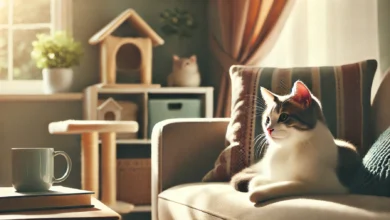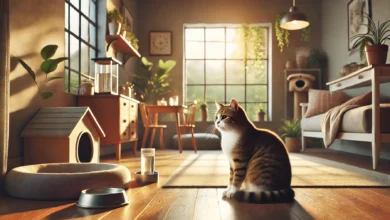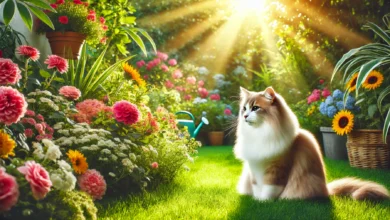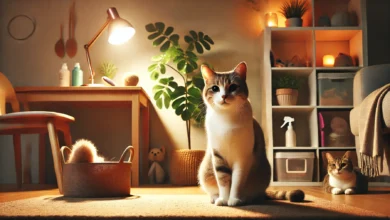Treating Cat Constipation with Dietary Adjustments
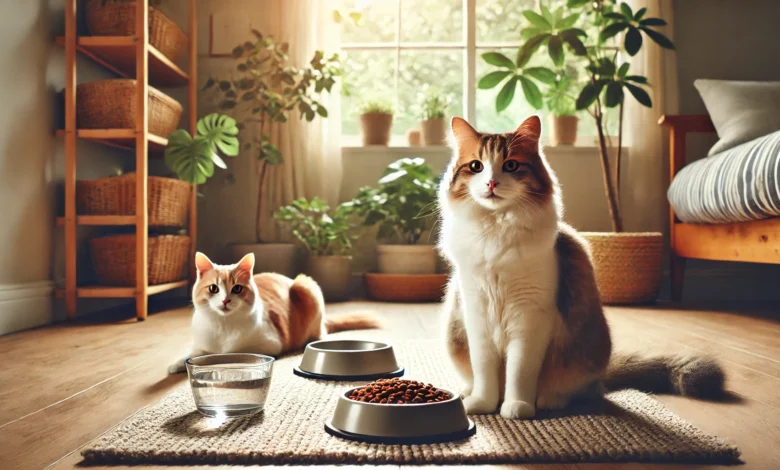
Caring for your cat’s health is very important, and making sure their digestive system works well is a great part of that.
Cat constipation may be a common problem since it often causes discomfort and serious health problems if not addressed.
Just like in humans, constipation in cats may arise for numerous reasons; the good thing, however, is that it can often be managed with simple dietary adjustments.
By knowing the causes and symptoms of cat constipation, you can take proper steps to help your feline friend maintain a healthy and normal digestive system.
You may consider your cat as suffering from constipation if you notice them frequently straining at the litter box or not having a bowel movement for days.
This can be alarming for any pet owner, but rest assured, with the right information and some careful dietary adjustments for your cat, you can help relieve the problem and support your cat’s long-term health.
Now, let’s delve into the causes and symptoms of constipation in cats and how you can identify them.
Table of Contents
Understanding Cat Constipation: Causes and Symptoms
Cat constipation occurs when a cat is unable to easily pass stools, and it can be caused by several factors.
If left untreated, it can lead to more severe conditions like megacolon or intestinal blockage.
Knowing its causes and signs will give you the opportunity to act early, making proper dietary adjustments to prevent this condition from becoming chronic.
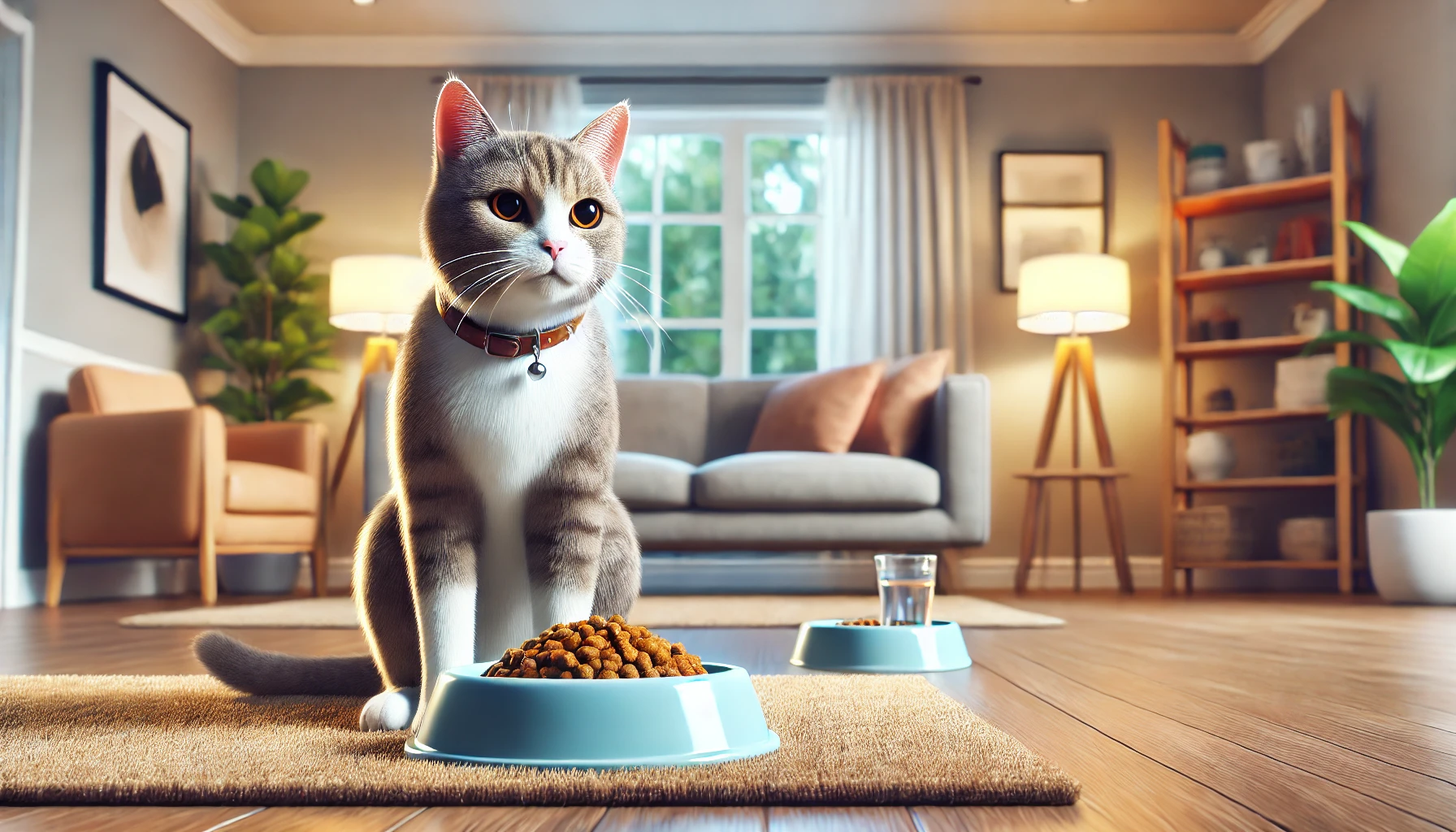
Common Causes of Cat Constipation
Constipation in cats can result from a variety of causes, including:
- Dehydration: Cats that don’t drink enough water may experience dry, hard stools, making it difficult to pass.
- Low-fiber diet: A diet that contains very low amounts of fiber can result in sluggish digestion due to the slowing down of food movement through the digestive tract.
- Lack of exercise: Indoor cats or felines that do not exercise regularly tend to have slower digestion.
- Hairballs: Grooming and swallowing hair can lead to blockages in the intestines.
- Underlying illness: Conditions like kidney disease, diabetes, and even spinal cord injuries can interfere with bowel movements.
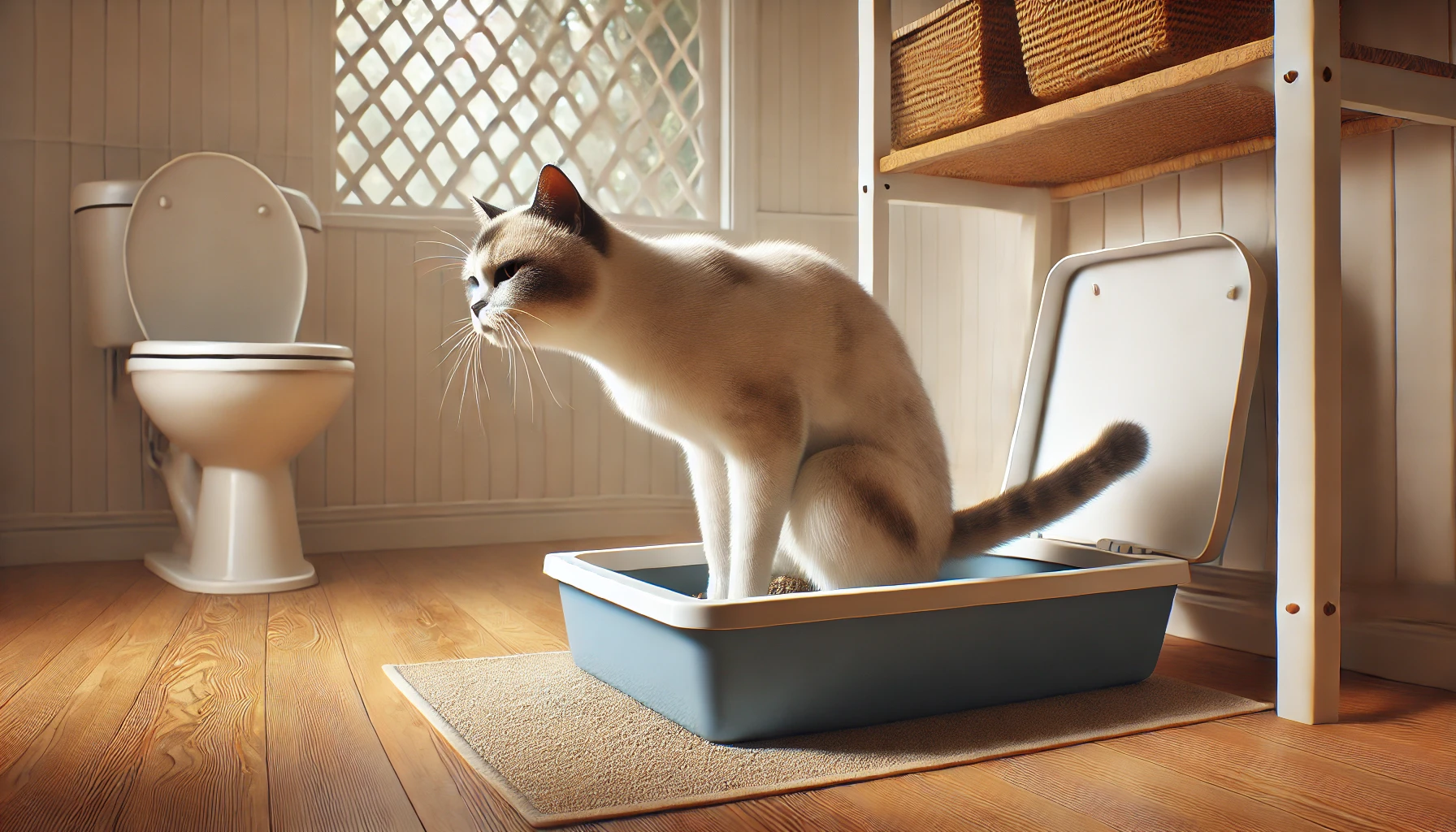
Recognizing the Symptoms of Cat Constipation
Being aware of the symptoms of cat constipation is just as important as understanding its causes.
Some common symptoms include:
- Rare bowel movements: Infrequent passage of stools, occurring less often than normal, can be a sign of constipation.
- Straining in the litter box: Cats may spend more time in the litter box, straining or even crying out in discomfort.
- Hard, dry stools: When your cat does pass stools, they may be small, hard, or dry.
- Loss of appetite or vomiting: Severe constipation can cause nausea, loss of appetite, and sometimes even vomiting.
- Lethargy: A constipated cat may act lethargic and uninterested in activities they would normally enjoy.
If you notice these symptoms, it’s important to take action quickly by consulting your veterinarian and making dietary changes to help relieve the problem.
Diet is the key to taking care of your cat’s digestive health, and the prevention of cat constipation begins with reevaluating what your cat eats each day.
Cats are obligate carnivores, meaning they require a diet high in animal-based proteins.
However, fiber, moisture, and balanced nutrients are also essential for keeping the digestive system running smoothly.
Poor digestion, due to imbalances in the diet—such as inadequate fiber or insufficient water intake—can lead to cat constipation.
Fortunately, several dietary modifications can prevent these problems from escalating into serious health conditions.
Here are some of the dietary changes that can make a significant difference in preventing cat constipation.
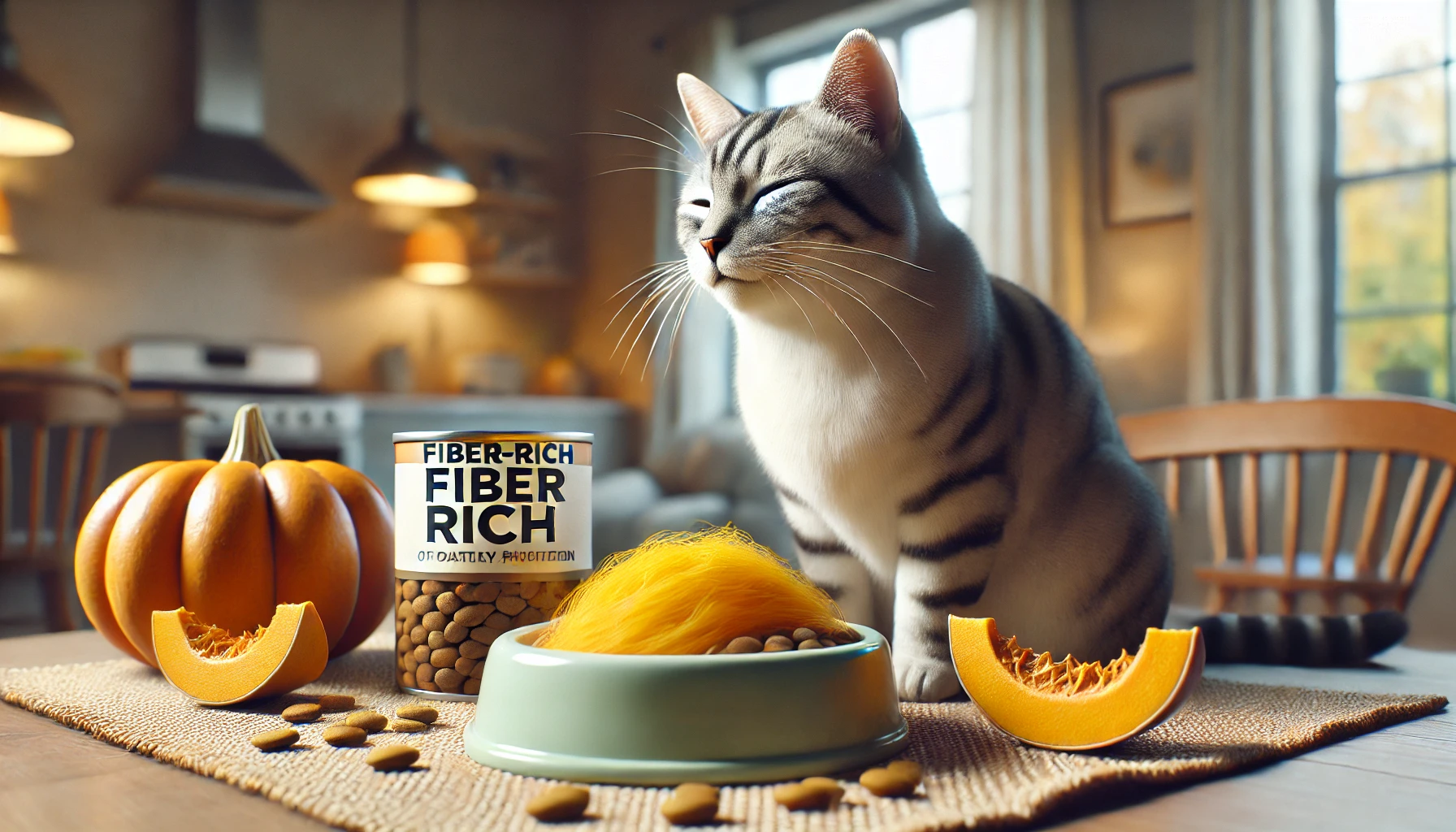
Preserving Digestive Health with Fiber-Rich Foods
Fiber is essential for regulating bowel movements in both dogs and cats.
While cats don’t need large amounts of fiber in their diet, a small amount can help things move along more easily.
Many commercial cat foods contain fiber sources such as beet pulp, pumpkin, or psyllium husk.
If your cat isn’t getting enough fiber, they may start showing signs of cat constipation.
Adding a small amount of canned pumpkin to meals can also help soften the cat’s stool due to its high water and fiber content, but it’s important not to overdo it, as too much fiber can cause digestive issues.
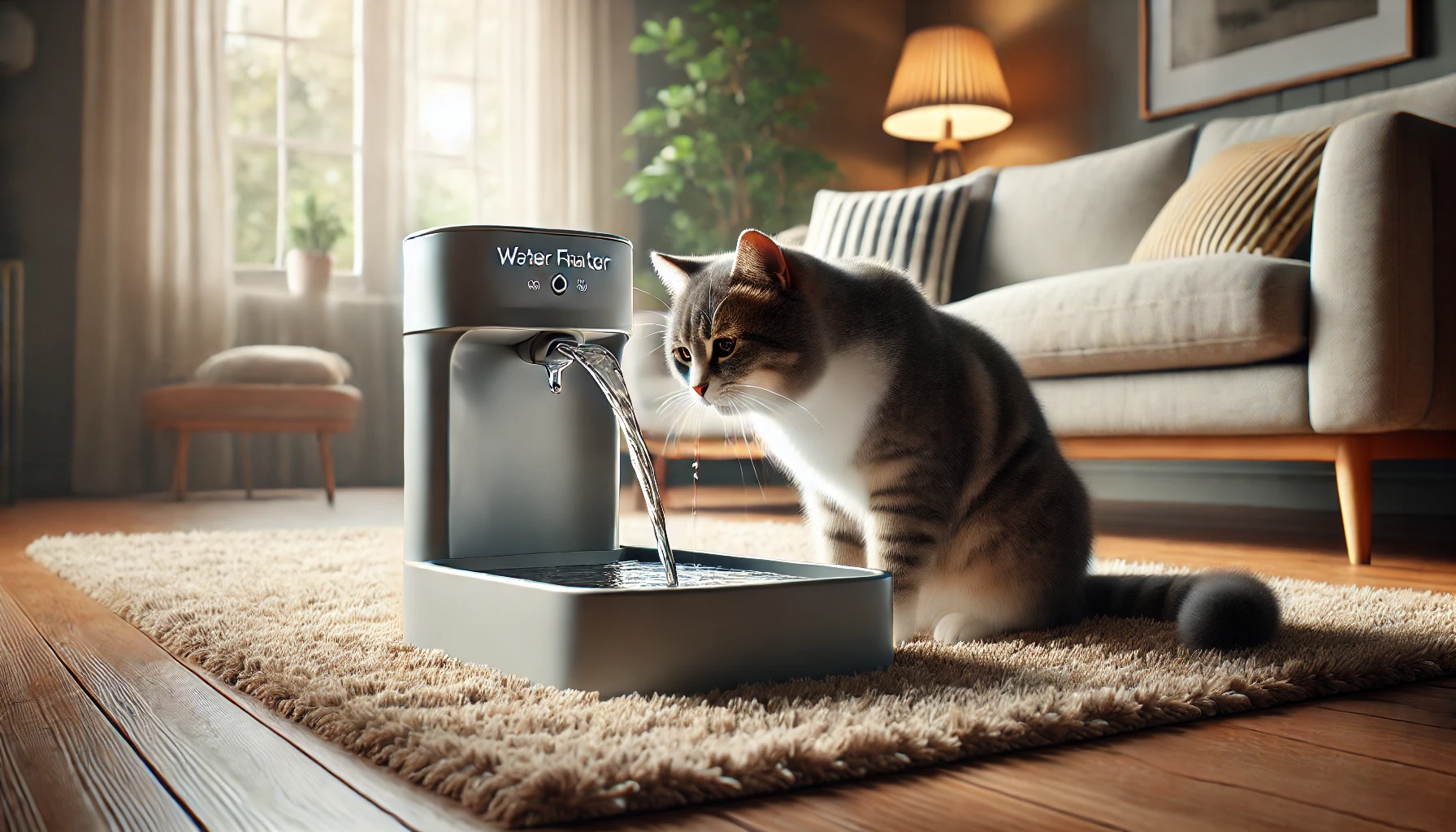
Increasing Moisture Intake
One of the most effective strategies for preventing cat constipation is ensuring your cat gets enough water.
Cats are not always good at drinking on their own and are often prone to dehydration.
This is especially true for cats that primarily eat dry food, as kibble contains little moisture.
To balance this, try incorporating more wet food into your cat’s diet.
Wet food has a higher water content, which helps keep the intestines hydrated.
You can also encourage your cat to drink more water by placing several bowls around your home or using a water fountain, as cats are often attracted to running water.
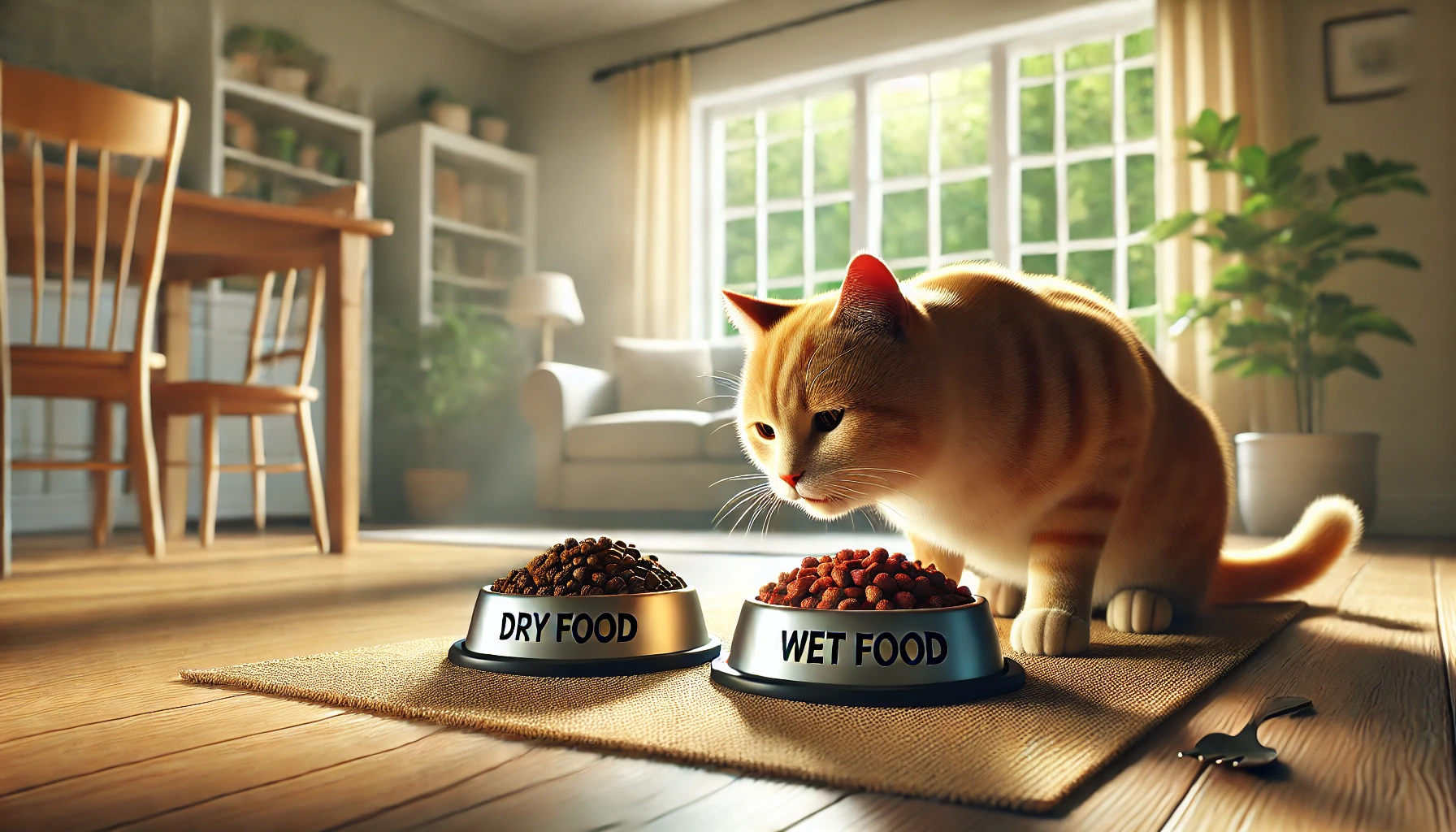
The Importance of a Nutritionally Balanced Diet
Just like in humans, a nutritionally balanced diet is essential for your cat’s overall health, including digestion.
High-quality, nutritionally complete cat food with the right balance of protein, fat, fiber, and moisture helps prevent issues like cat constipation.
Avoid giving your cat too many treats, human food, or low-quality cat food lacking essential nutrients.
If your cat has had digestive issues in the past, consult your veterinarian to select the best food for their specific needs.
Proper nutrition promotes regular bowel movements and helps avoid the discomfort associated with constipation.
Understanding the root causes and signs of cat constipation helps pet owners take proactive steps in managing their feline’s digestive health. By staying informed, you can prevent severe conditions like megacolon and ensure a healthier lifestyle for your cat.
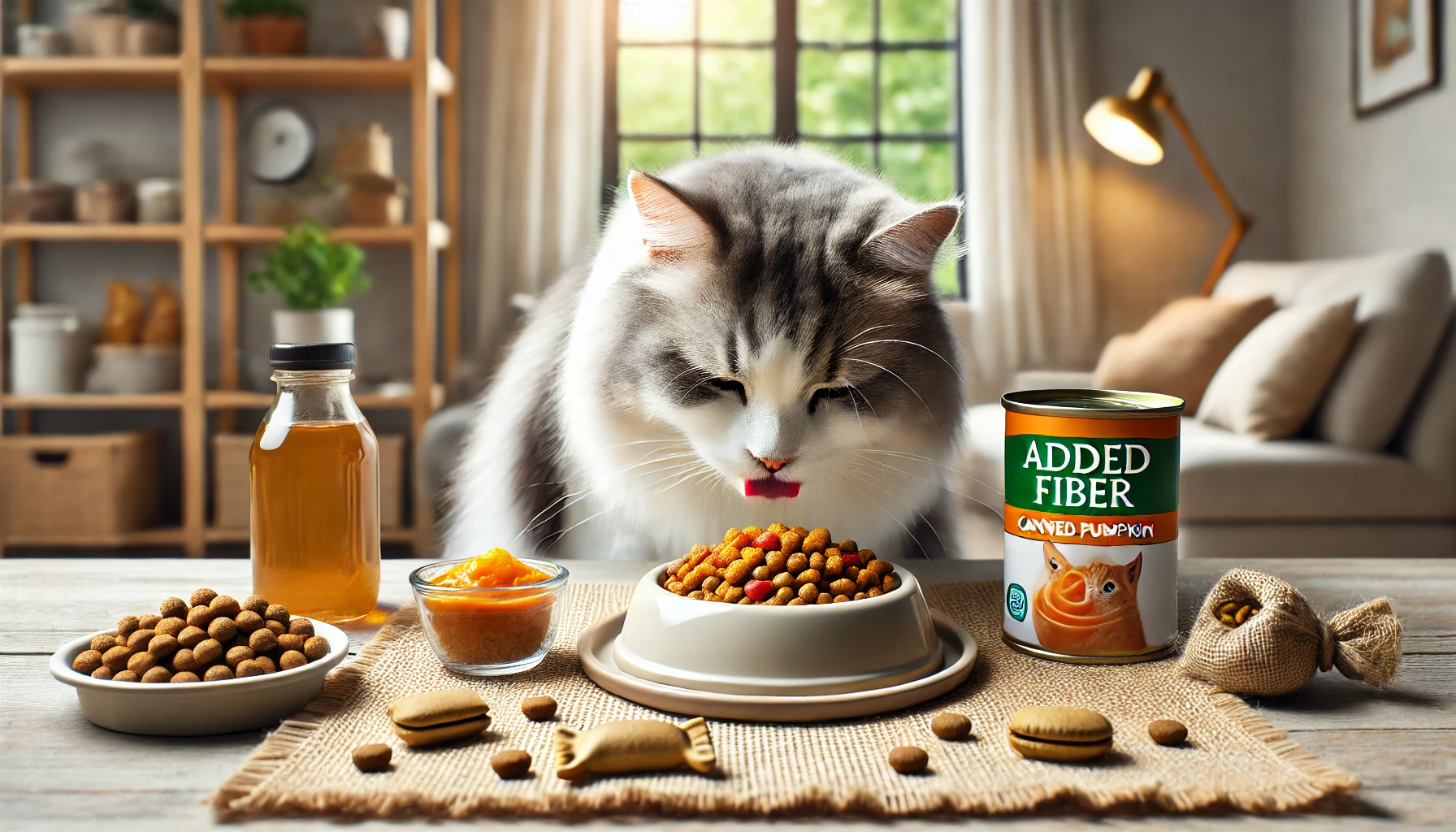
Dietary Changes to Cure Cat Constipation
Dietary changes can be highly effective in alleviating cat constipation and improving your cat’s digestive health.
Making thoughtful adjustments to your cat’s diet can help manage constipation symptoms and address underlying issues.
By increasing fiber and moisture in their diet, you can tackle the root causes of cat constipation and support your feline friend’s overall well-being.

Introducing Fiber-Rich Foods
One of the first steps in treating cat constipation is adding fiber to their diet.
Fiber helps bulk up the stool and facilitates its passage through the intestines.
Here are some excellent sources of fiber for cats:
- Pumpkin: Canned pumpkin is a well-known remedy for constipation. It is rich in fiber and moisture, which helps soften the stool. Always choose plain, unflavored, and unsweetened canned pumpkin to avoid unnecessary additives.
- Psyllium husk: This is a highly effective fiber supplement often found in gastrointestinal products. It helps absorb water and softens the feces, making it easier to pass. Psyllium husk should be used according to the dosage recommended by your veterinarian.
- Specialized cat food: Some cat foods are formulated with higher fiber content to address digestive issues like constipation. Consult with your veterinarian to select a suitable food that meets your cat’s specific needs.
When introducing fiber into your cat’s diet, do so gradually to prevent sudden digestive disturbances.
Monitor your cat’s response closely, as too much fiber at once can lead to gas or diarrhea.
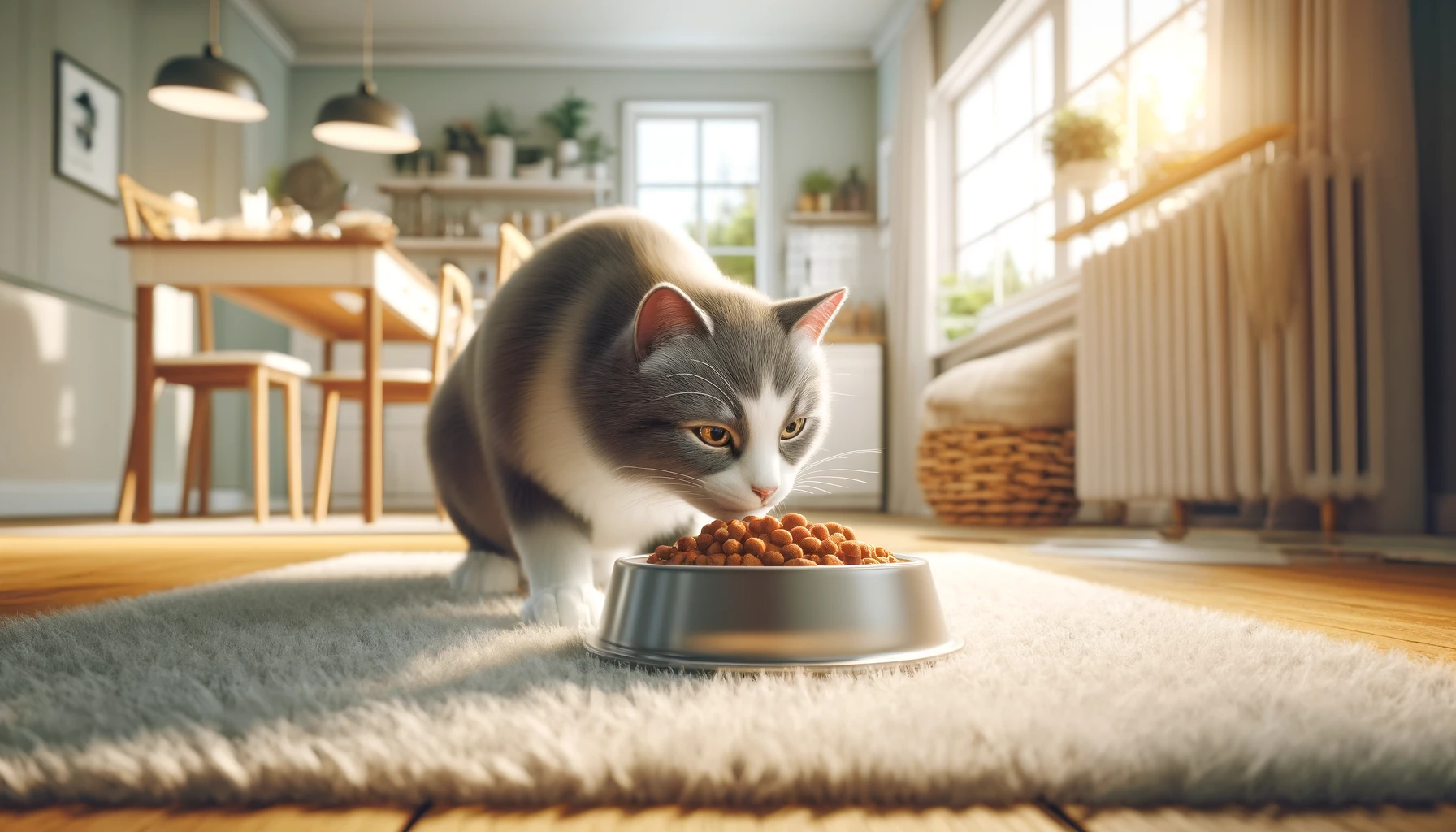
Increasing Wet Food Intake
In addition to adding fiber, increasing the amount of wet food in your cat’s diet is crucial.
Wet food contains significantly more moisture than dry kibble, which helps keep the stool hydrated and easier to pass.
This can be particularly beneficial for cats prone to dehydration.
Consider mixing wet food with your cat’s current diet or replacing some of their dry meals with canned options.
This not only aids in hydration but also adds variety to their diet, which can stimulate their appetite and make mealtime more enjoyable.
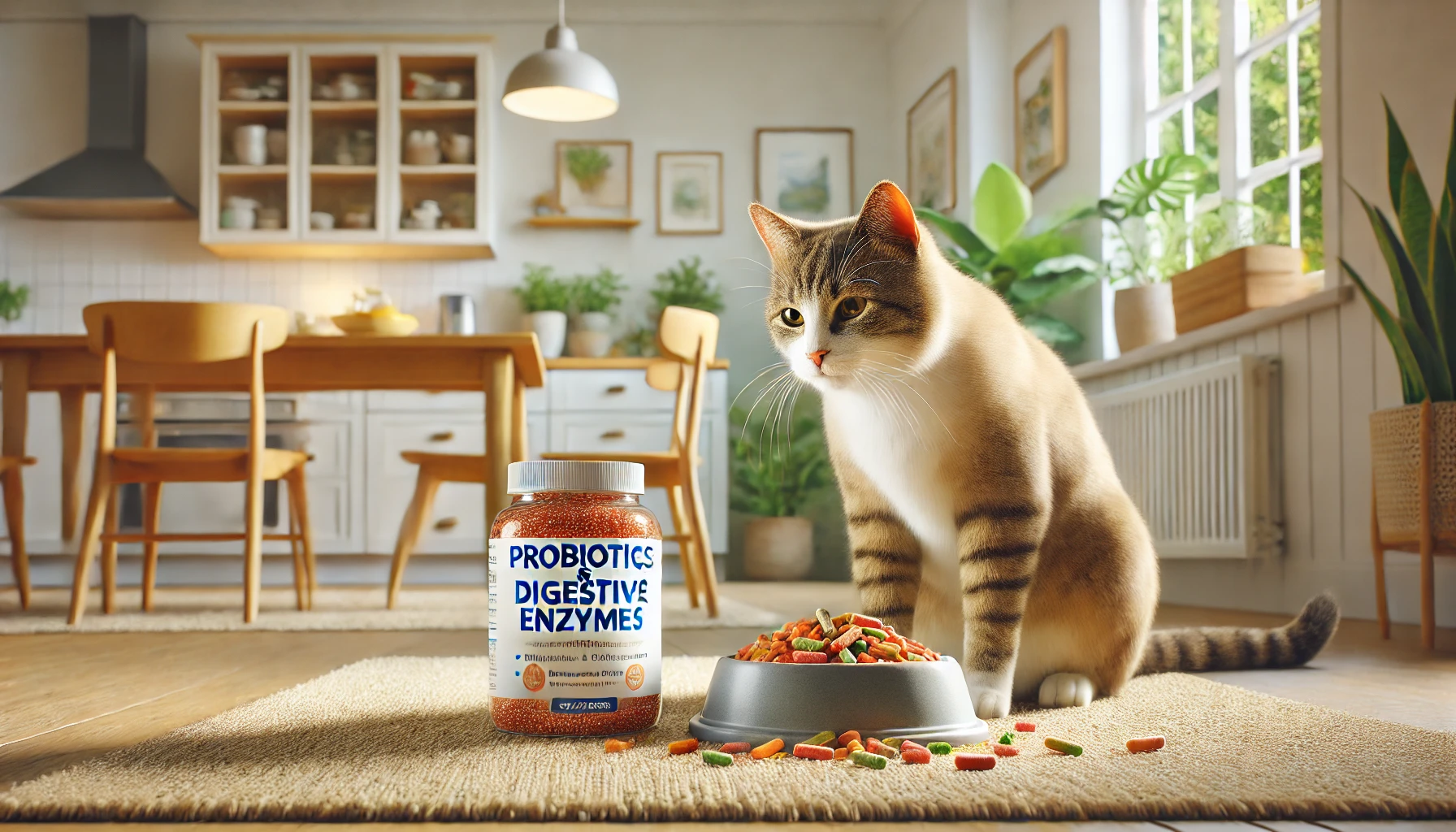
Using Probiotics and Digestive Enzymes
Probiotics and digestive enzymes can also play a role in treating cat constipation.
Probiotics introduce beneficial bacteria into the gut, which helps regulate digestion and bowel movements.
Digestive enzymes can assist in breaking down food more efficiently, improving overall digestion.
Both supplements can be found in various pet health products.
Consult with your veterinarian to determine the appropriate type and dosage for your cat.
Making the right dietary changes can relieve your cat’s constipation. Gradually introducing fiber, increasing wet food, and consulting with your vet for specialized food are good ways to manage the issue.
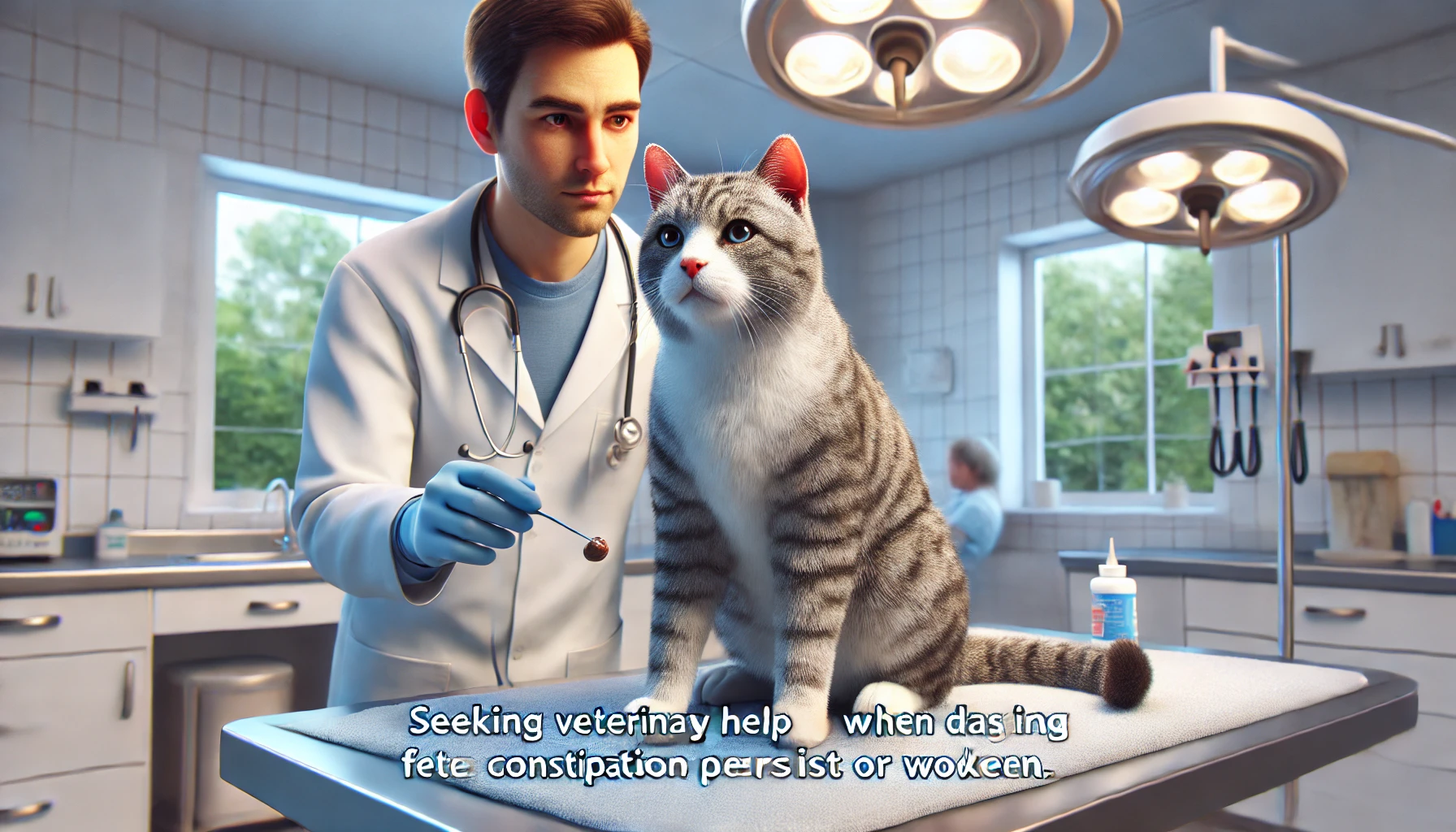
When to Engage a Veterinarian for Feline Constipation
While dietary changes can significantly help in managing cat constipation, there are situations where professional veterinary intervention becomes necessary.
If your cat continues to experience constipation despite your efforts with dietary adjustments, or if you observe any concerning symptoms, it’s crucial to consult a veterinarian.
Recognizing when to seek professional help can ensure your cat receives the appropriate care and avoids potential complications.
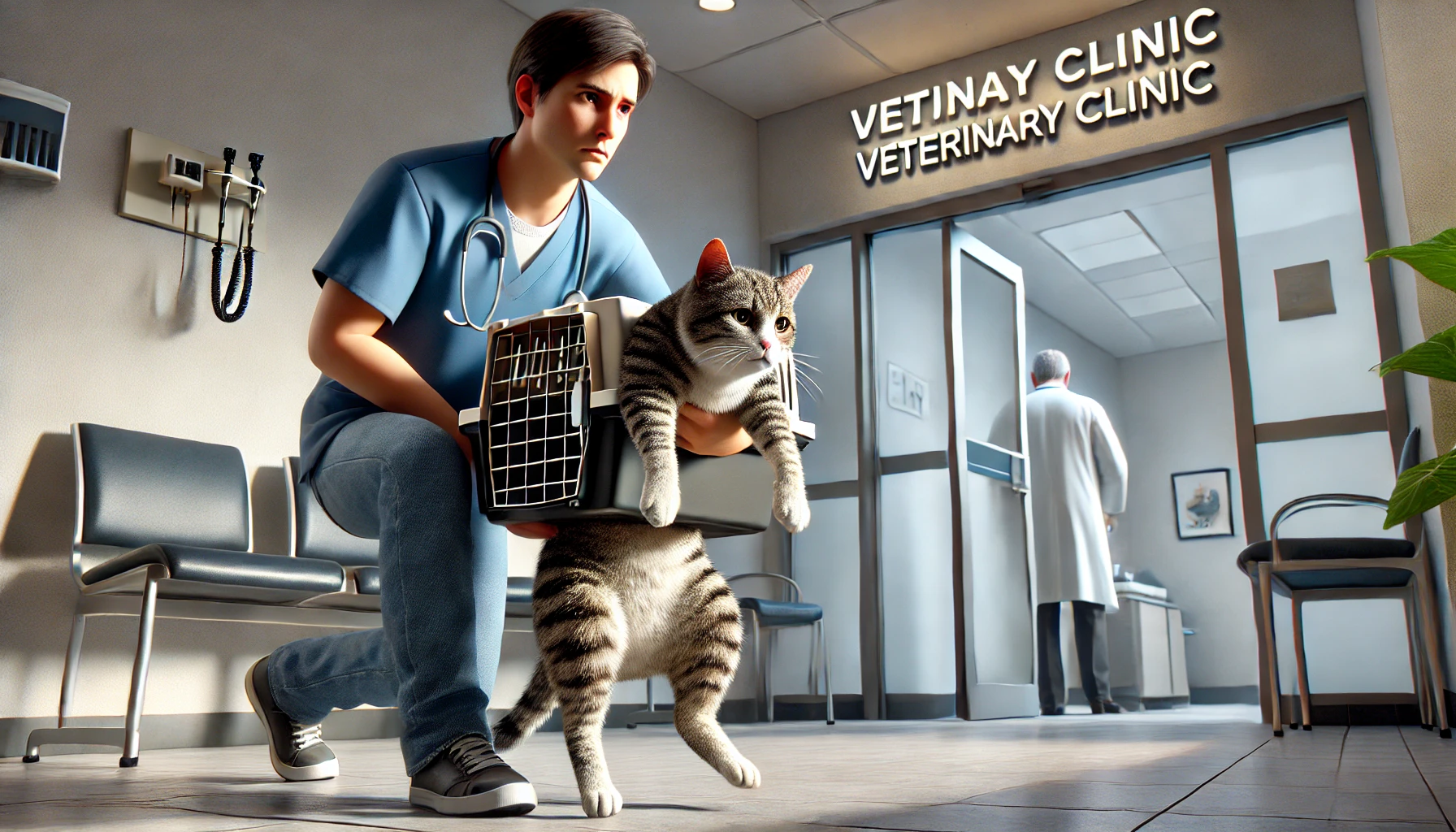
Signs Requiring Immediate Veterinary Attention
Constipation can sometimes be a symptom of a more serious underlying condition.
Watch for these signs that indicate a visit to the veterinarian is warranted:
- Chronic Constipation: If your cat has not had a bowel movement for more than 48-72 hours despite dietary changes, this could indicate a serious issue requiring veterinary attention.
- Severe Straining: Excessive straining in the litter box, especially if accompanied by vocalizing or signs of pain, may indicate a more severe problem such as an intestinal blockage.
- Vomiting or Loss of Appetite: If your cat is vomiting or has a decreased appetite along with constipation, this could suggest an underlying health issue that needs immediate treatment.
- Bloody or Mucous Stools: The presence of blood or mucus in your cat’s stool is a red flag and should prompt a vet visit as soon as possible.
- Discomfort, Pain, or Swelling in the Abdomen: Signs of discomfort, pain, or abdominal swelling can indicate severe underlying disorders such as megacolon or intestinal obstruction, and require urgent veterinary attention.
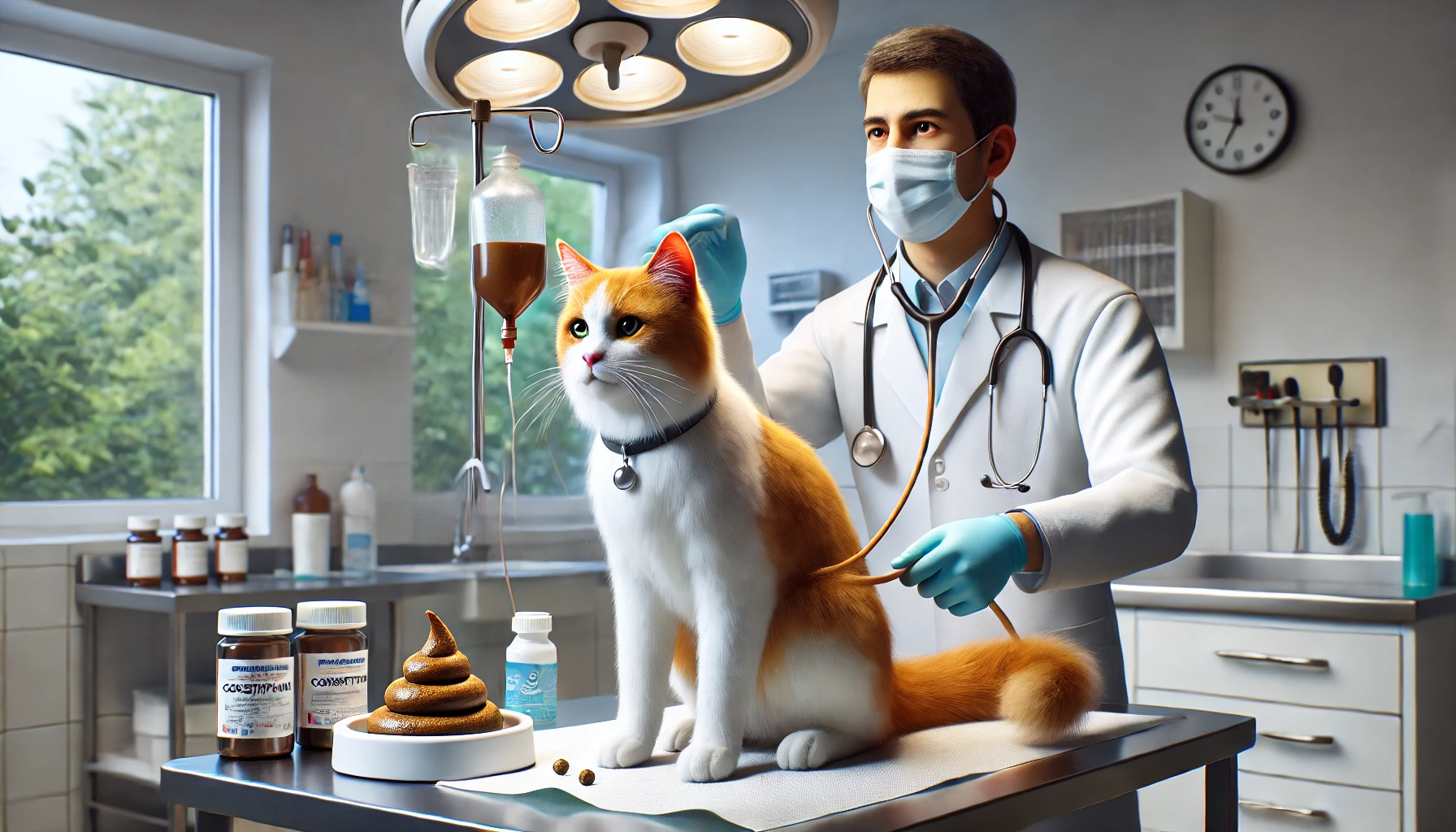
Veterinary Treatments for Feline Constipation
If your veterinarian determines that your cat needs medical treatment for cat constipation, they may recommend several options based on the severity of the condition:
- Medications: Your vet may prescribe medications such as laxatives, stool softeners, or prokinetic agents to help relieve constipation. These medications work by either softening the stool or stimulating bowel movements.
- Enemas: In some cases, your vet may administer an enema to help clear the colon. This procedure can relieve constipation by helping to remove hard stools from the rectum.
- Dietary Adjustments: Your vet might suggest specific dietary changes or supplements tailored to your cat’s condition. These adjustments can help manage and prevent future constipation.
- Surgery: In rare cases where other treatments are ineffective, surgical intervention may be necessary to address severe conditions such as megacolon or intestinal obstructions.
Timely veterinary care can help resolve cat constipation effectively and prevent long-term health issues.
Always consult your veterinarian if you have any concerns about your cat’s digestive health.
Recognizing when professional help is necessary can make a difference in your cat’s recovery. If dietary changes don’t help or if symptoms persist, it’s time to consult your vet.
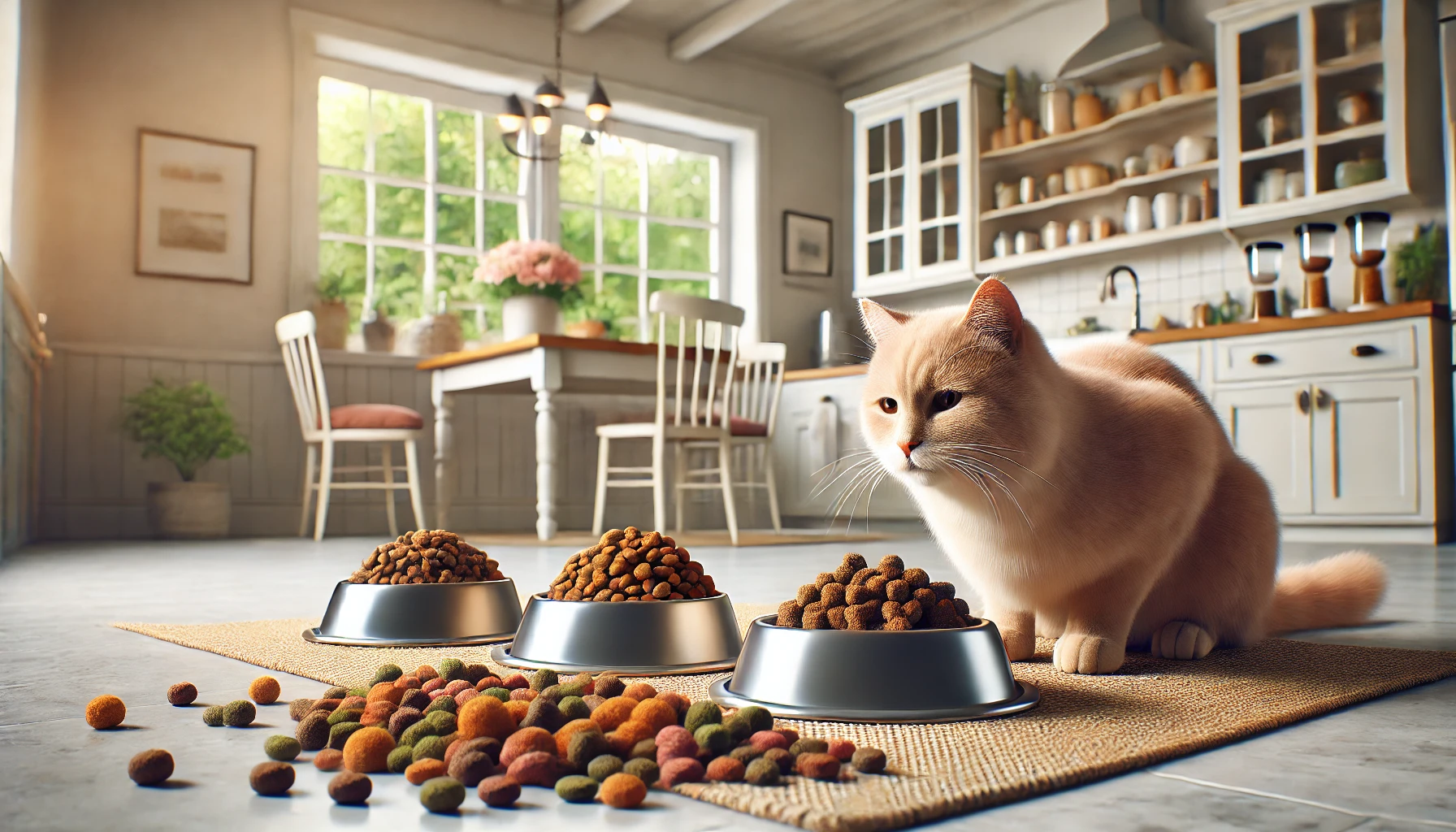
Long-term Dietary Strategies for the Prevention of Cat Constipation
Preventing cat constipation requires implementing effective long-term dietary strategies to ensure your feline friend maintains optimal digestive health.
By making thoughtful changes to your cat’s diet and lifestyle, you can reduce the likelihood of constipation recurring and support their overall well-being.
Here are some proven strategies to keep your cat’s digestive system running smoothly.
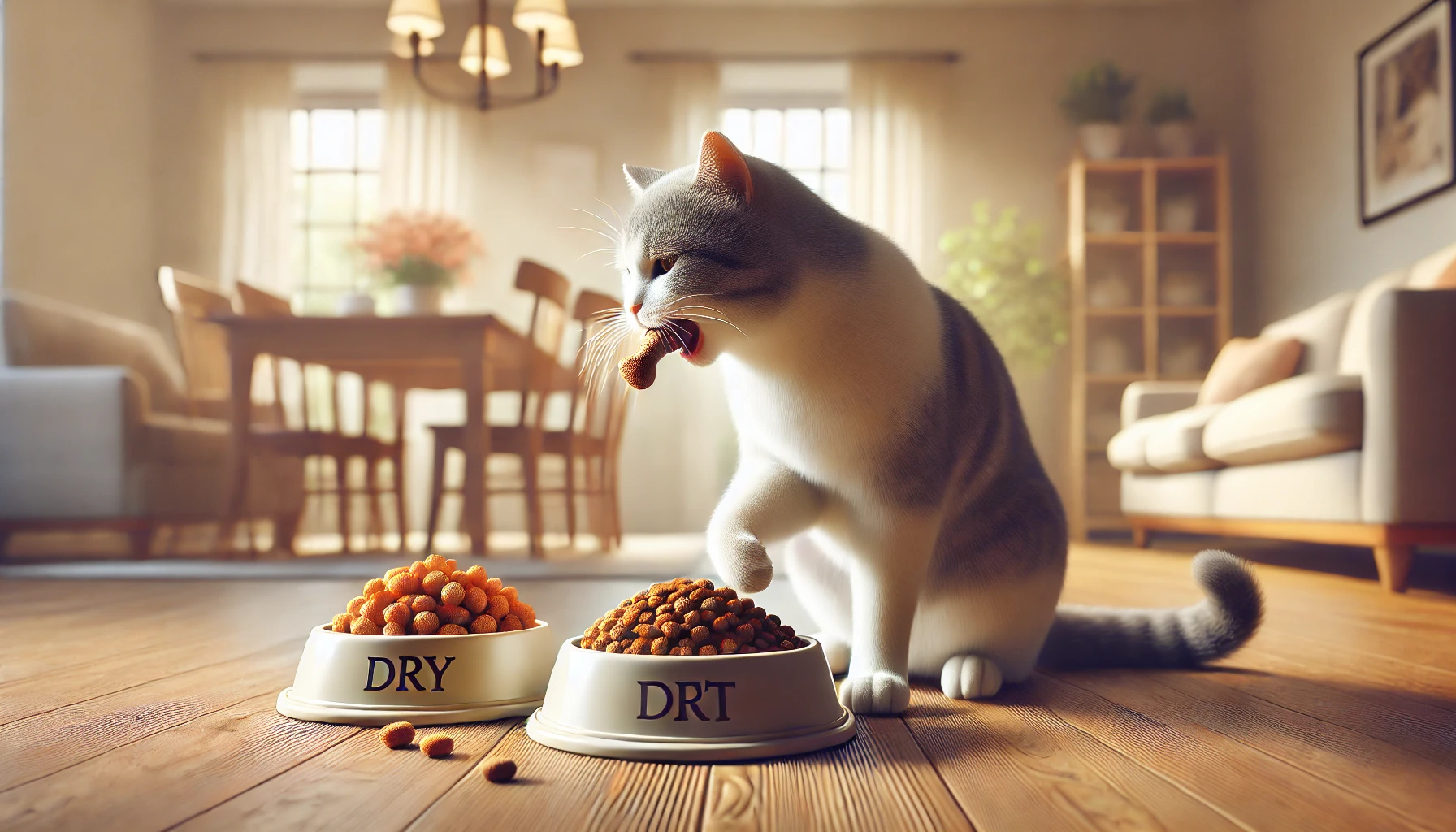
Maintaining the Right Balance of Diet
Proper nutrition plays a crucial role in preventing constipation.
A diet with balanced nutrients, fiber, protein, and moisture supports healthy digestion.
Consider the following:
- Premium Cat Food: Choose high-quality commercial cat food that offers a balanced diet with essential nutrients, including proteins, fats, fiber, and moisture. Opt for foods that use natural ingredients and avoid excessive fillers or artificial additives.
- Consistent Fiber Levels: Ensure that the fiber content in your cat’s diet remains stable. Fiber aids in regulating bowel movements and prevents constipation. Avoid making abrupt changes in fiber levels, as this can disrupt your cat’s digestive system.
- Regular Feeding Schedule: Establish and maintain a consistent feeding routine. Regular meal times help regulate your cat’s digestive system and promote regular bowel movements.
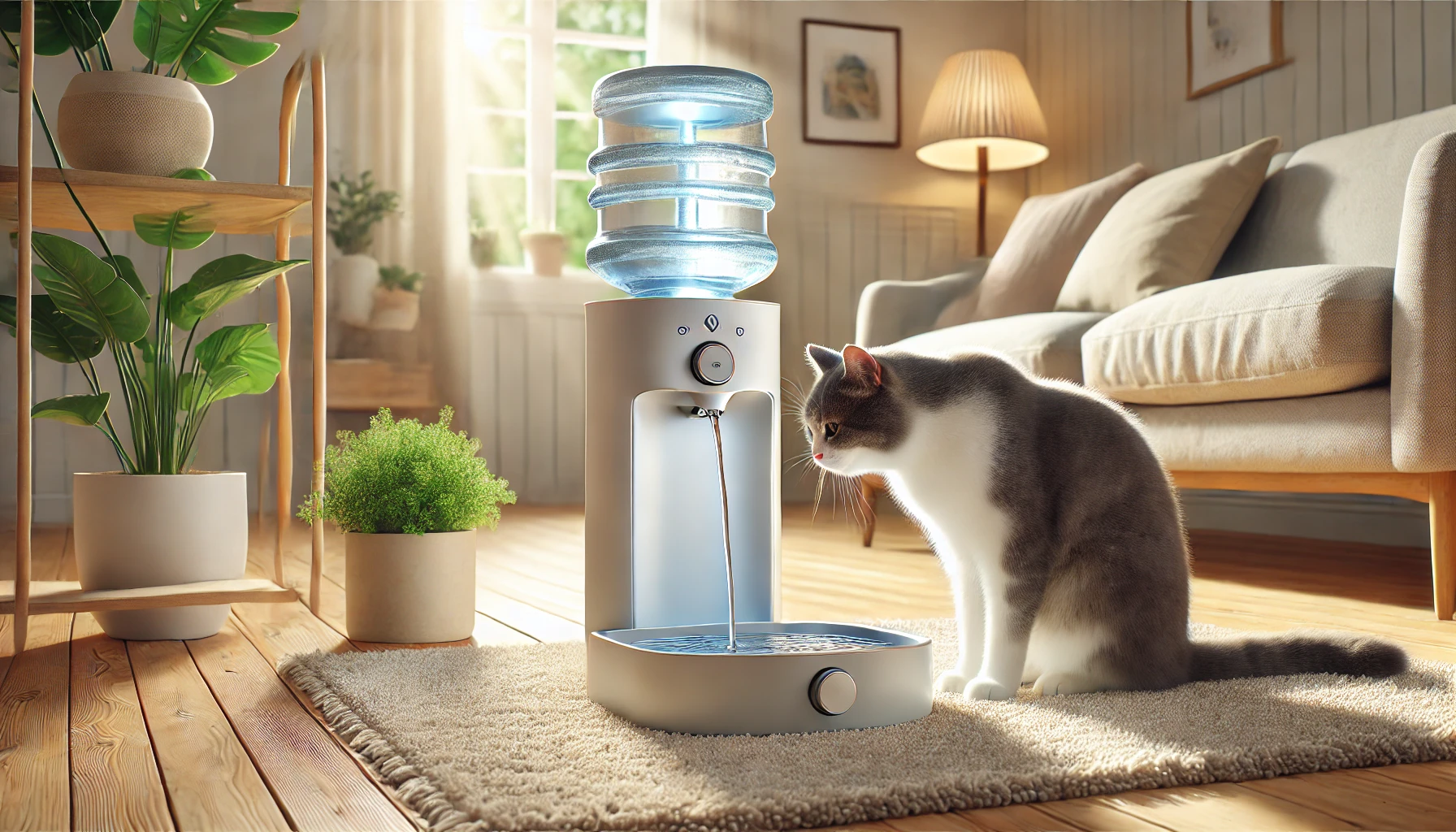
Encouraging Proper Hydration
Hydration is critical in preventing constipation.
Cats are prone to dehydration, which can exacerbate digestive issues.
To ensure your cat stays well-hydrated, follow these tips:
- Provide Fresh Water: Always offer fresh, clean water. Place multiple water bowls around your home to encourage your cat to drink more.
- Use a Water Fountain: Many cats prefer running water. Consider investing in a water fountain to attract your cat and increase their water intake.
- Incorporate Wet Food: Adding wet food to your cat’s diet can boost moisture intake. Wet food is often more appealing to cats and provides additional hydration.
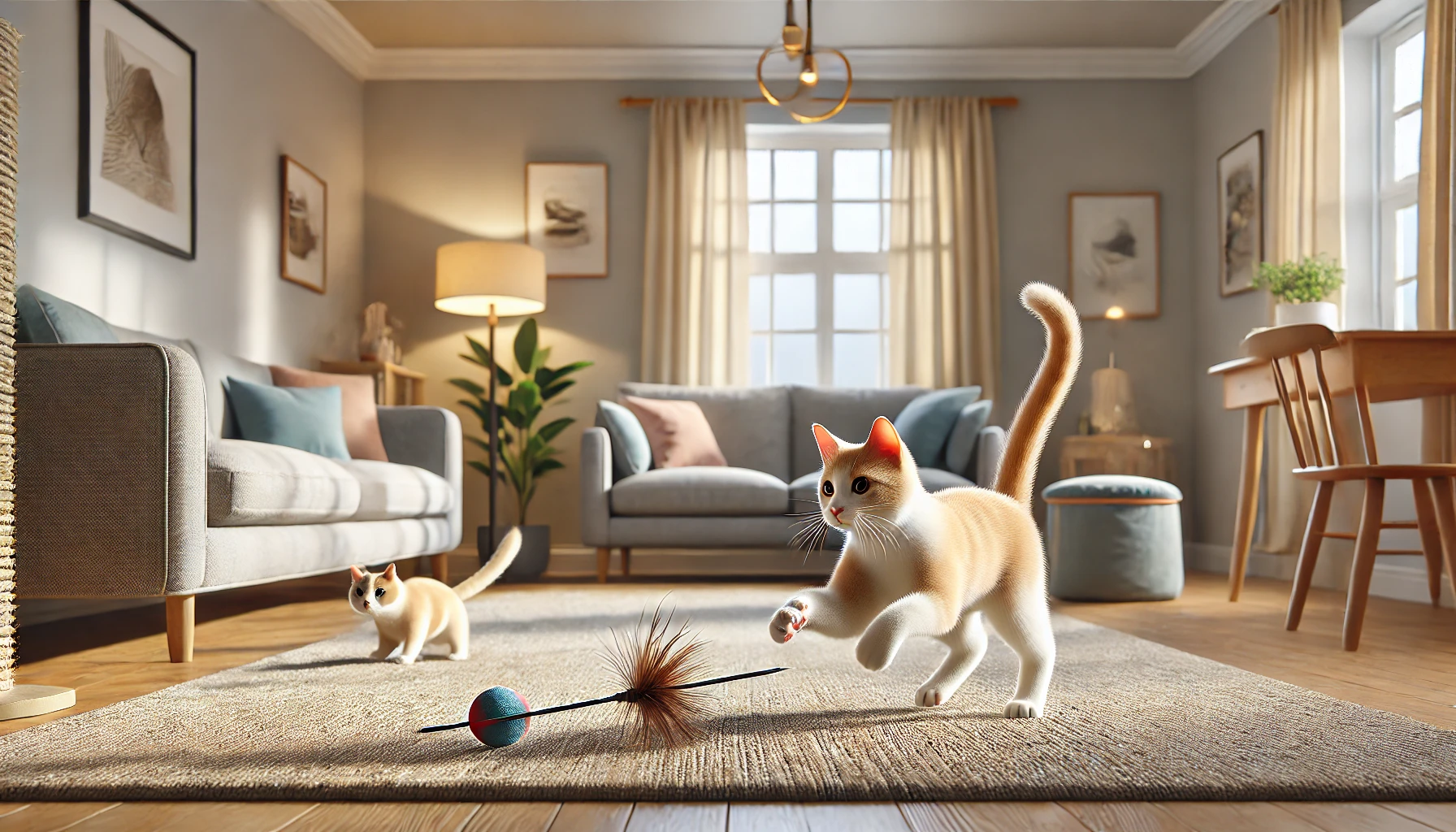
Promoting Regular Exercise
Physical activity supports healthy digestion and helps prevent constipation.
Encourage your cat to stay active with these strategies:
- Interactive Play: Engage your cat in regular interactive play sessions. Toys like feather wands, laser pointers, and catnip-filled toys can stimulate your cat’s interest and promote exercise.
- Environmental Enrichment: Provide opportunities for exploration and exercise. Cat trees, scratching posts, and climbing structures can encourage your cat to move more.
- Scheduled Playtime: Incorporate daily playtime into your cat’s routine. Regular activity helps maintain a healthy digestive system and prevents constipation.
By following these long-term dietary strategies and maintaining a consistent routine, you can help your cat avoid constipation and promote overall digestive health.
If you have any concerns or notice persistent issues, consulting with your veterinarian is always a wise choice.
Preventing constipation involves maintaining a balanced diet with adequate fiber, proper hydration, and regular exercise. These strategies help keep your cat’s digestive system in good health.
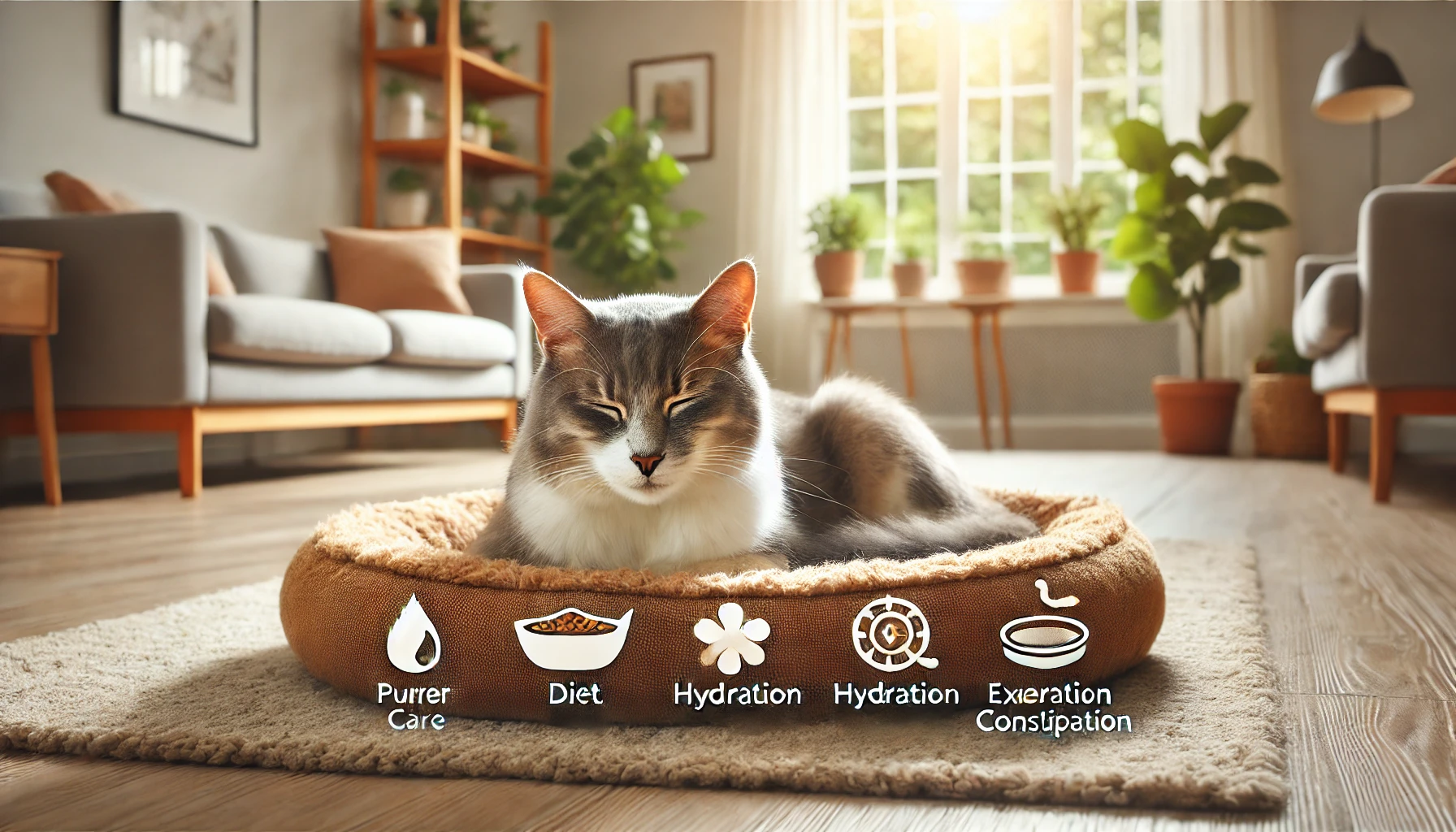
Summary: Caring for and Preventing Feline Constipation
Understanding feline constipation and taking proactive steps to manage it are crucial for ensuring your cat leads a healthy, happy life.
If left unmanaged, constipation in cats can lead to serious health consequences.
By recognizing its causes and symptoms and making appropriate dietary changes, you can significantly improve your cat’s gastrointestinal health and prevent future issues.
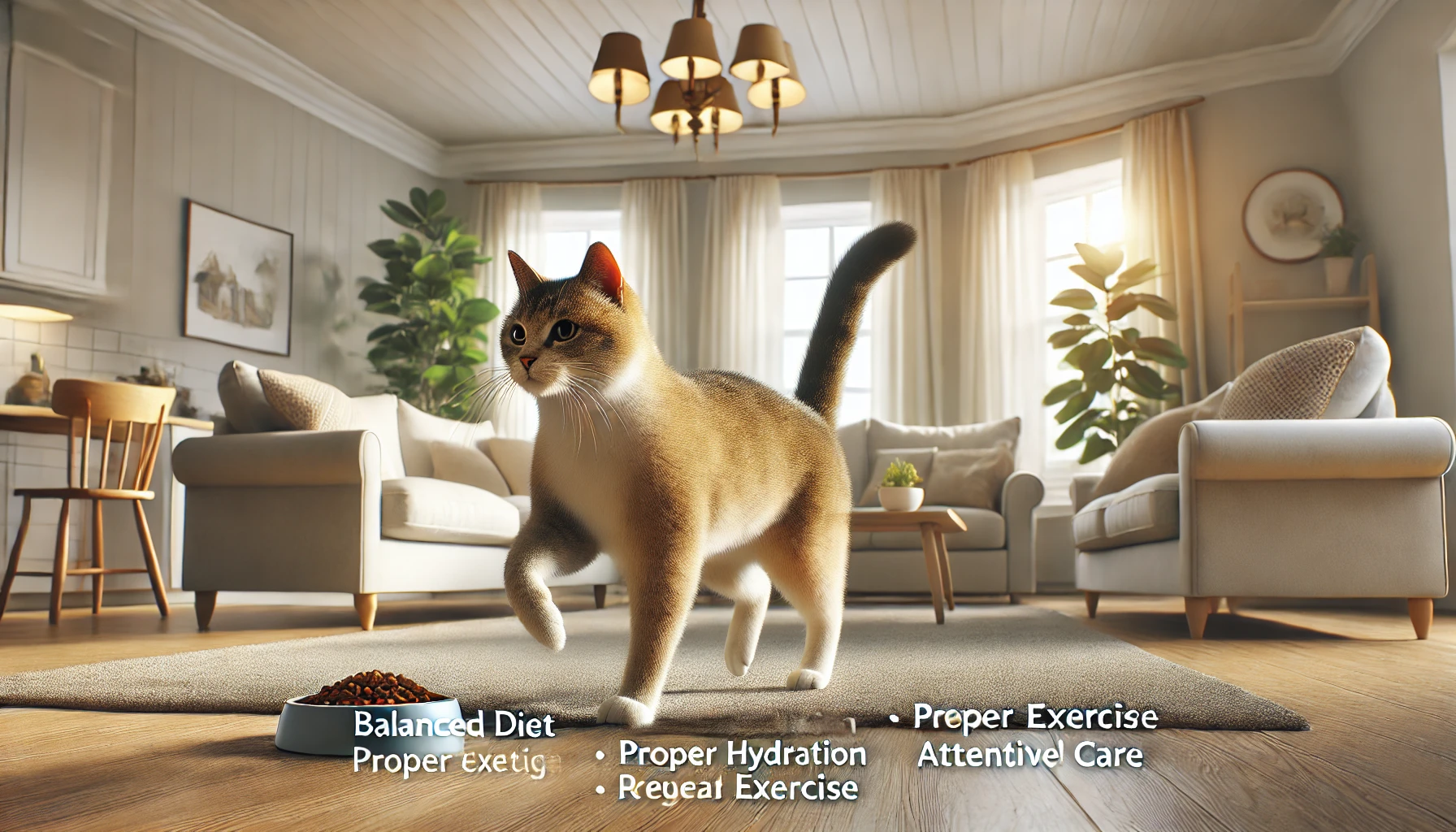
Key Takeaways
- Recognize the Signs: Be vigilant for symptoms such as infrequent bowel movements, straining, and discomfort. Early identification allows for timely intervention.
- Dietary Changes: Enhance your cat’s diet by increasing fiber with sources like canned pumpkin and psyllium husk, and add moisture through wet food to improve hydration and stool consistency.
- Encourage Hydration: Ensure your cat always has access to fresh water. Consider using a water fountain to stimulate drinking and include wet food in their diet to boost moisture intake.
- Promote Regular Exercise: Engage your cat in regular physical activity to support digestion and prevent constipation.
- Consult a Veterinarian: If constipation persists despite dietary adjustments or if your cat shows additional concerning symptoms, seek veterinary advice promptly.
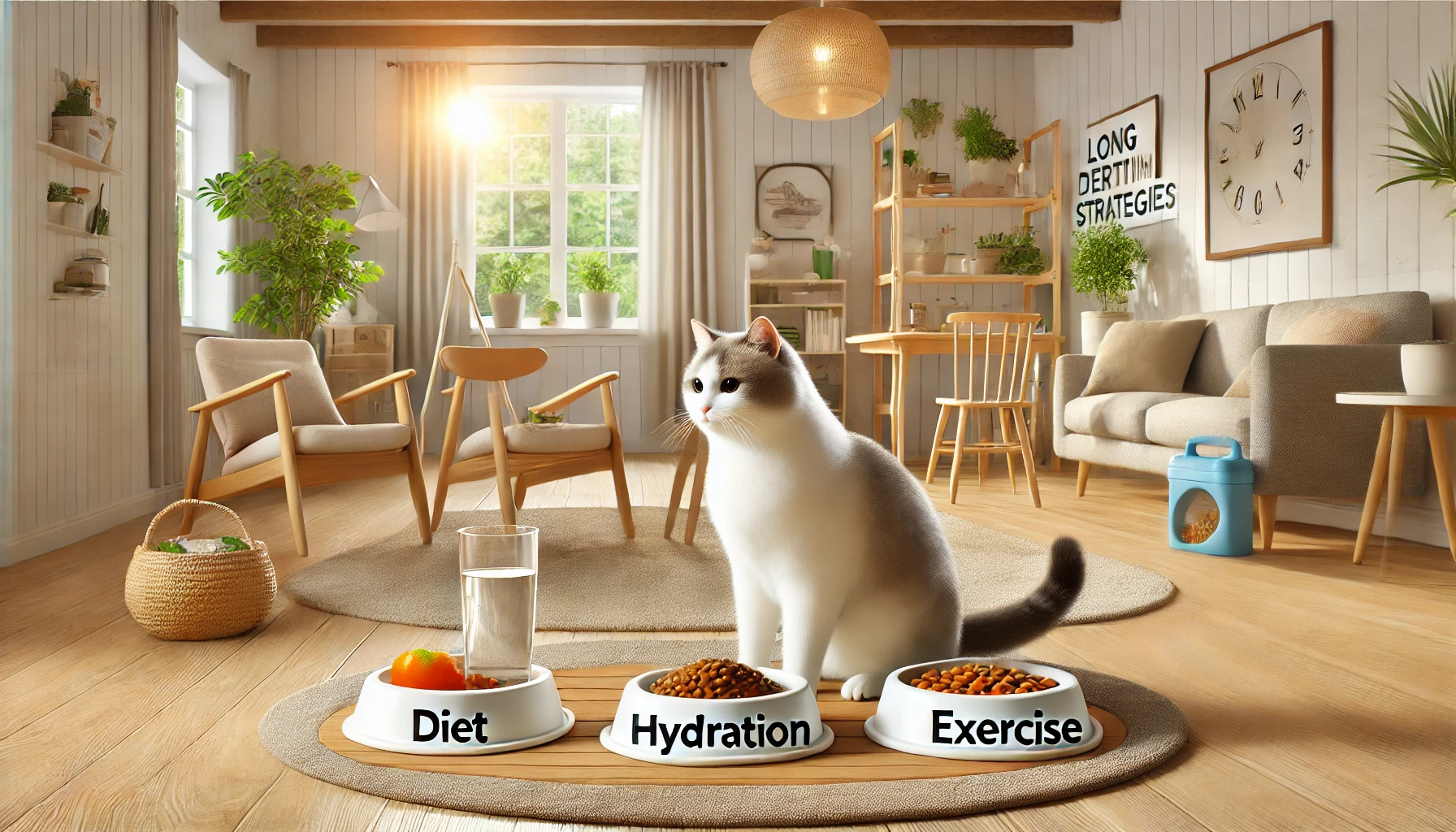
Long-term Prevention Strategies
For long-term prevention of cat constipation, focus on maintaining a balanced diet with adequate fiber and hydration.
Establish a consistent feeding schedule and encourage regular exercise.
These measures will help keep your cat’s digestive system healthy and functioning optimally.
In summary, effectively managing feline constipation involves a combination of proper nutrition, adequate hydration, regular exercise, and vigilant monitoring.
By following these guidelines, you can support your cat’s digestive health and improve their overall quality of life.
Always consult your veterinarian for personalized advice and treatment if you have any concerns about your cat’s health.
Preventing feline constipation requires vigilance, balanced nutrition, hydration, and exercise. Addressing symptoms early can greatly enhance your cat’s quality of life.
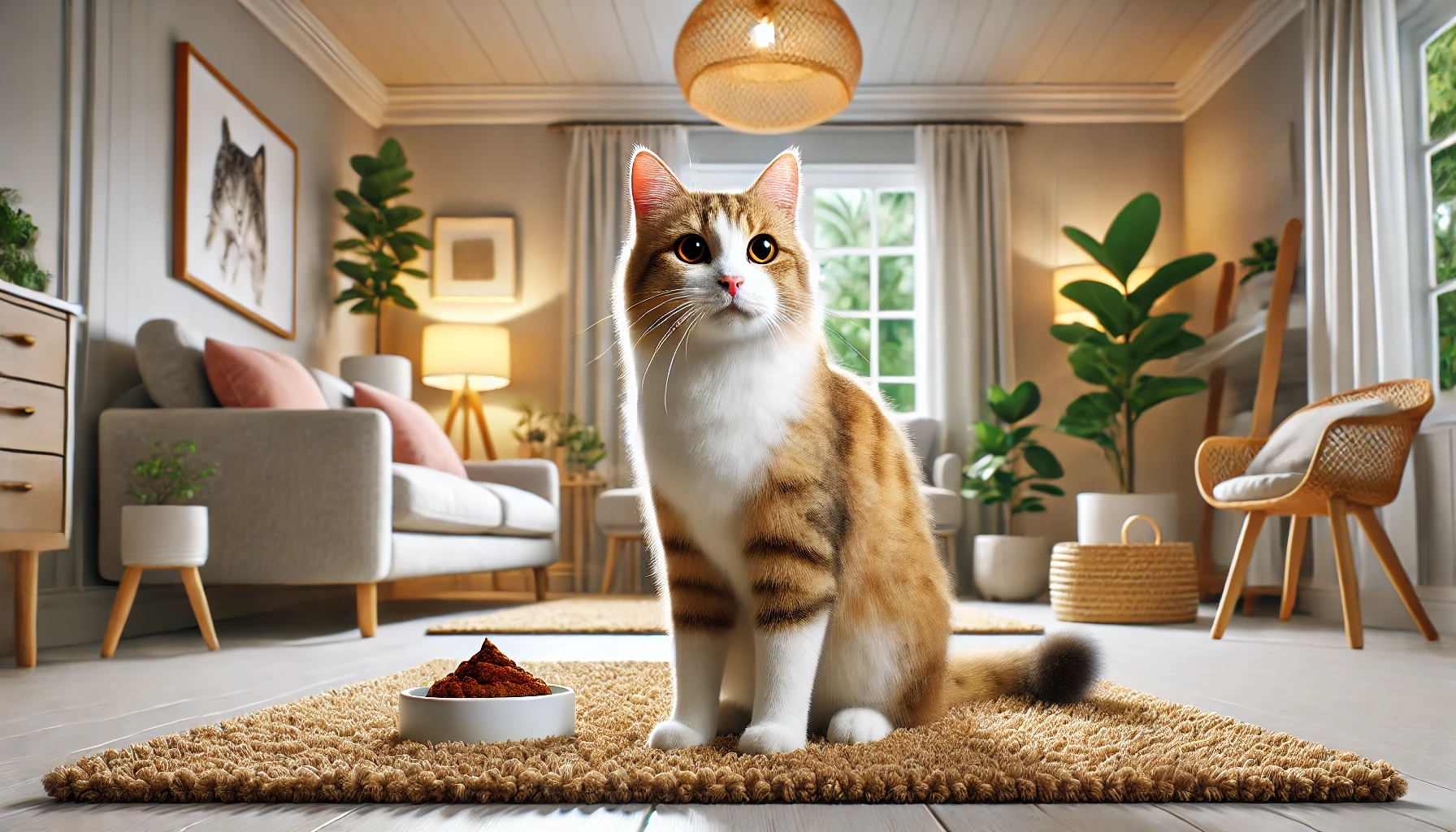
Frequently Asked Questions About Feline Constipation
Here are some common questions about feline constipation and their answers to help you better understand and manage this condition.
What are common symptoms of constipation in cats?
Common signs include less frequent bowel movements, difficulty when passing stools or defecation, presence of hard stools, and displaying uneasiness or pain during the use of a litter box.
How do I prevent constipation in my cat?
Prevent constipation by offering a well-rounded diet that includes fiber, plenty of water, the addition of wet food, and frequent exercise.
When should I bring in my cat for constipation to the vet?
See your veterinarian if your cat hasn’t passed stool for more than 48-72 hours, has severe straining, vomiting, loss of appetite, or blood in the stool.
Can adding fiber to my cat's diet help with constipation?
Yes, adding fibrous foods like canned pumpkin or psyllium husk will help bulk up the stool and make it easier for your cat to pass, relieving constipation.
What role does hydration play in managing cat constipation?
Hydration is crucial; well-hydrated stool is softer and easier to pass.
Providing fresh water and incorporating wet food into your cat’s diet can significantly help prevent constipation.
How do I get my cat to drink more water?
Encourage drinking by placing multiple water bowls around the house, using a water fountain, and incorporating wet food to boost moisture intake.
Can over-the-counter laxatives for cats be given?
Consult your veterinarian before using any over-the-counter laxatives.
They can recommend safe and effective treatments for your cat’s condition.
What diet is to be given to a constipated cat?
Add fiber with food items such as canned pumpkin or psyllium husk, and ensure moisture by including wet food.
Make dietary changes gradually to prevent digestive upsets.

